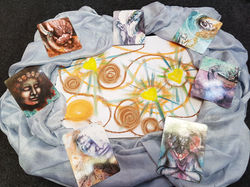
"The body always leads us home if we can simply learn to trust sensation and stay with it long enough for it to reveal appropriate action, movement, insight or feeling" - Pat Ogden, Ph.d

"Through the sandtray, barriers can be torn down and healing paths created where no such thing previously existed." Amy Flaherty

From the first touch of the sand, there is often a palpable release of tension, as the body begins to find it's natural rhythm again." Bonnie Badenoch

"The body always leads us home if we can simply learn to trust sensation and stay with it long enough for it to reveal appropriate action, movement, insight or feeling" - Pat Ogden, Ph.d
Sandtrays and art work used with clients' permission
1.
Individual
Psychotherapy
"Often the hands know how to solve a riddle
with which the intellect has wrestled in vain."
- Carl Jung, psychologist and psychiatrist
Sandplay Therapy for Adults and Teenagers
The benefits of Sandplay Therapy:
-
A means by which children and adults, unable to articulate their feelings and experiences, enable expression and integration
-
An activation of our natural, self-healing capacity
-
Safe entry into the deeper realms of the psyche
-
A means of self-discovery, healing and integration
-
A transformation or redirection of blocked energy
-
Abuse
-
Anxiety, depression
-
Post Natal depression
-
Behavioral issues
-
Bullying or being bullied - work place or school
-
Burnout
-
Connecting to self
-
Re-authoring self-identity
-
Decision making
-
Grief and Loss
-
Relationships and family issues
-
Helps adults and children when previous "talk therapy" felt unwelcome
-
Sandplay is especially beneficial to clients experiencing mild to severe trauma.
What can Sandplay Therapy assist with:
Talk Therapy for Adults
ACT, CBT, DBT, SFT, ... lets not get hung up on acronyms. These are talk therapies. They are evidence based, effective, timeless, person- centred, strengths-based one on one counselling modalities.
Eye Movement Desensitisation Reprocessing (EMDR)
Is an interactive psychotherapy treatment designed to alleviate psychological stress as a result of disturbing life experiences. However, unlike many forms of talk therapy, EMDR focuses less on the source of the stress or the traumatic event that precipitated it and more on the distressing emotions and symptoms associated with it. People can experience fast, effective outcomes that once took years to make a difference.

Expressive Therapies for Adults, Teenagers and Pre-teens
Formerly known as Emotional Release Counselling.
Most of us have at some time disconnected from feelings, repressed painful or overwhelming experiences, and disowned various aspects of ourselves. In doing so, our sense of self is diminished. In some cases, particularly where abuse or traumatic events have occurred, the wounding has caused a disconnect from self. As a consequence, we lose our ability to experience the joy and passion of life.
Expressive Therapies (ET) help to bring about a heightened awareness of ourselves, and the way we live our lives. ET allows deeper aspects of the psyche to be worked with naturally and safely by using a multiple mediums:
-
Symbol Work
-
Body Focus / Body Awareness / Body Maps
-
Mindfulness / Visualisation / Meditation / Relaxation Techniques
-
Art / Drawing / Expressive Writing
-
Mandala Artwork
-
Dream Work
-
Bioenergetics / Movement / Dance
-
Body Focused Guided Drawing
Clients draw with both hands and eyes closed as they focus on their felt sense. Physical pain,
tension, and emotions are expressed without words through bilateral scribbles. Clients then, with an
almost massage-like approach, find movements that soothe their pain, discharge inner tension and
emotions, and repair boundary breaches. Sensorimotor art therapy is a unique and self-empowering
application of somatic experiencing. It is both body-focused and trauma-informed in approach and
assists clients who have experienced complex traumatic events to actively respond to overwhelming
experiences until they feel less helpless and overwhelmed and are then able to repair their memories
of the past.
 |  |  |
|---|---|---|
 |  |  |
 |  |  |
 |  |


To Heal Trauma, Work with the Body
It's not all just in your head...
Aug 20, 2017 Jennifer Sweeton Psy.D. PSYCHOLOGY TODAY
"Any time that we process information we form explicit memories and implicit memories. Explicit memories are the factual information, general knowledge, and autobiographical information. Implicit memories are the emotional responses and body sensations- this part doesn’t have to do with fact, but feeling ... We need to address the physical in order to solve the problem. So, the next time that you are struggling with healing from your trauma, remind yourself that your body is doing exactly what it is supposed to do. It is protecting you. You just need a little work on re calibrating the alarm system ... Working together, we can process the trauma so that it is a part of your story and not something that needs avoiding. We just need to work with your body a little ... Several coping mechanisms that may work for you include breathing techniques, mindfulness, meditation ... It may take a moment to explore different techniques until you find one that works for you"
%20(236%20x%20194%20px)%20(224%20x%2087%20px).png)